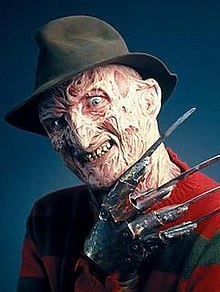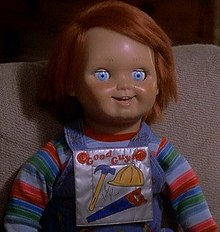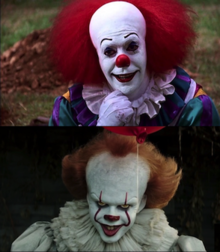The Blues Brothers (film)
Jump to navigation Jump to search| The Blues Brothers | |
|---|---|
 Theatrical release poster | |
| Directed by | John Landis |
| Produced by | Robert K. Weiss |
| Written by |
|
| Starring | |
| Cinematography | Stephen M. Katz |
| Edited by | George Folsey Jr. |
| Distributed by | Universal Pictures |
Release date |
|
Running time | 133 minutes[1] |
| Country | United States |
| Language | English |
| Budget | $30 million[2] |
| Box office | $115.2 million[3] |
The Blues Brothers is a 1980 American musical comedy film directed by John Landis.[4] It stars John Belushi and Dan Aykroyd as "Joliet" Jake and Elwood Blues, characters developed from "The Blues Brothers" recurring musical sketch on the NBC variety series Saturday Night Live. The film is set in and around Chicago, Illinois, where it was filmed. The film's screenplay was written by Aykroyd and Landis. It features musical numbers by rhythm and blues (R&B), soul, and blues singers James Brown, Cab Calloway, Aretha Franklin, Ray Charles, and John Lee Hooker. It features non-musical supporting performances by Carrie Fisher, Henry Gibson, Charles Napier and John Candy.
The story is a tale of redemption for paroled convict Jake and his blood brother Elwood, who set out on "a mission from God" to save the Catholic orphanage in which they were raised from foreclosure. To do so, they must reunite their R&B band and organize a performance to earn $5,000 needed to pay the orphanage's property tax bill. Along the way, they are targeted by a homicidal "mystery woman", Neo-Nazis, and a country and western band—all while being relentlessly pursued by the police.
Universal Studios, which had won the bidding war for the film, was hoping to take advantage of Belushi's popularity in the wake of Saturday Night Live, Animal House, and the Blues Brothers' musical success; it soon found itself unable to control production costs. The start of filming was delayed when Aykroyd, new to film screenwriting, took six months to deliver a long and unconventional script that Landis had to rewrite before production, which began without a final budget. On location in Chicago, Belushi's partying and drug use caused lengthy and costly delays that, along with the destructive car chases depicted onscreen, made the final film one of the most expensive comedies ever produced.
Concerns that the film would fail limited its initial bookings to less than half those a film of its magnitude normally received. Released in the United States on June 20, 1980, it received mostly positive reviews. It earned just under $5 million in its opening weekend and went on to gross over $115 million in theaters worldwide before its release on home video. It has become a cult classic, spawning the sequel, Blues Brothers 2000, 18 years later, which was a critical and commercial failure.
Freddy Krueger
Jump to navigation Jump to search| Freddy Krueger | |
|---|---|
| A Nightmare on Elm Street character | |
 Robert Englund as Freddy Krueger | |
| First appearance | A Nightmare on Elm Street |
| Created by | Wes Craven |
| Portrayed by | |
| Information | |
| Alias | The Springwood Slasher |
| Species | Dream Demon (formerly human) |
| Classification | Mass murderer[1] |
| Primary location | Springwood, Ohio |
| Signature weapon | Bladed work glove |
Freddy Krueger (/ˈkruːɡər/) is a fictional character and the main antagonist of the A Nightmare on Elm Street film series. He first appeared in Wes Craven's A Nightmare on Elm Street (1984) as the spirit of a serial killer who uses a gloved hand with razors to kill his victims in their dreams, causing their deaths in the real world as well. In the dream world, he is a powerful force and almost completely invulnerable. However, whenever Freddy is pulled into the real world, he has normal human vulnerabilities and can be destroyed.
The character was created by Wes Craven and was consistently portrayed by Robert Englund in the original film series as well as in the television spin-off. In the 2010 franchise reboot, Freddy Krueger was portrayed by Jackie Earle Haley. In 2011, Freddy appeared as a playable character in the video game Mortal Kombat[2] and in 2017 as a playable character in Dead by Daylight. Over the course of the series, Freddy has battled numerous survivors including Nancy Thompson and Alice Johnson.[3]
The original film introduced his backstory as "The Springwood
Slasher", a serial killer of children who had been burned to death by
his victims’ parents after evading prison.[4] This alias would be used in other films and media throughout the franchise, such as Freddy vs. Jason and the Nightmares on Elm Street comics.[5]
Pinhead (Hellraiser)
Jump to navigation Jump to searchThis article needs additional citations for verification. (July 2016) (Learn how and when to remove this template message) |
| Pinhead | |
|---|---|
| Hellraiser character | |
 | |
| First appearance | The Hellbound Heart |
| Created by | Clive Barker |
| Portrayed by | Doug Bradley (1987-2005) Stephan Smith Collins[1] (2011) Paul T. Taylor (2018) |
| Voiced by | Fred Tatasciore (2011) |
| Information | |
| Alias | Hell Priest[2] Lead cenobite The Pope of Hell[3] Dr. Paul Gregory[4] The Engineer[4] Cold Man |
| Species | Cenobite |
| Gender | Male |
| Real name | Elliott Spencer[5] |
| Primary location | "The Labyrinth"/Hell |
Pinhead is a fictional character from the Hellraiser series, first appearing as an unnamed figure in the Clive Barker novella The Hellbound Heart.[2] The name "Pinhead" is derived from a sobriquet given to him by the crew of the first Hellraiser film; he is first credited as such in Hellbound: Hellraiser II. Nearly thirty years after The Hellbound Heart was published, the character was given the designations the Hell Priest and the Cold Man in the sequels that followed, The Scarlet Gospels and Hellraiser: The Toll.
Pinhead is one of the leaders of the Cenobites, formerly humans but transformed into creatures which reside in an extradimensional realm, who travel to Earth through a puzzle box called the Lament Configuration in order to harvest human souls. His origins and the nature of the Cenobites vary depending upon the medium: while the character began as an amoral entity blindly devoted to the practice of experimental sadomasochism, later depictions have portrayed him as explicitly evil and even demonic in origin.
The character's appearance in 1987's Hellraiser marked a significant departure from the standard 1980s depiction of horror film villains, who tended to either be completely mute, or provide glib commentary while killing their victims. Rather, Pinhead was depicted as quiet yet articulate and intelligent, drawing influence from classical cinematic depictions of Count Dracula.[6]
In the film series he is revealed to once have been a regular man by the name of Elliott Spencer.
Chucky (character)
Jump to navigation Jump to search| Chucky | |
|---|---|
| Child's Play character | |
 The Chucky doll, as seen in Child's Play (1988) | |
| First appearance | Child's Play (1988) |
| Created by | Don Mancini John Lafia Tom Holland |
| Portrayed by | Brad Dourif John Franklin (walkabout; 1988 film) Brock Winkless (puppetry; films, 1–4)[1] Dan Fincher (puppetry; Seed of Chucky) Ed Gale (stunt double)[2][3] |
| Voiced by | Brad Dourif Edan Gross (Friendly Chucky) Fiona Dourif (Cult of Chucky; possessed) Mark Hamill (reboot film, Robot Chicken) |
| Information | |
| Full name | Charles Lee Ray |
| Alias | The Lakeshore Strangler |
| Nickname | Chucky |
| Species | Human (formerly) Doll |
| Spouse | Tiffany |
| Children | Glen (son) Glenda (daughter) |
| Classification | Serial killer |
| Power and abilities | Voodoo |
Charles Lee "Chucky" Ray is a fictional character and the main antagonist of the Child's Play slasher film franchise.
Chucky is portrayed as a notorious serial killer whose spirit inhabits a
"Good Guys" doll and continuously tries to transfer his soul from the
doll to a human body. The character has become one of the most
recognizable horror icons, often mentioned alongside Freddy Krueger, Jason Voorhees, Ghostface, Leatherface, Pennywise, Pinhead, and Michael Myers, and has been referenced numerous times in popular culture. In 1999, the Chucky character was nominated for the MTV Movie Award for Best Villain for the film Bride of Chucky. He was created by writer-director Don Mancini and is portrayed by Brad Dourif in both live action and voice over.[4] For the 2019 remake of the same name, Mark Hamill voiced Chucky, having previously voiced the Charles Lee Ray version of the character in an episode of Robot Chicken.
Leatherface
Jump to navigation Jump to search| Leatherface | |
|---|---|
| The Texas Chainsaw Massacre character | |
 Bill Johnson as Leatherface from The Texas Chainsaw Massacre 2 (1986) | |
| First appearance | The Texas Chain Saw Massacre |
| Created by | Kim Henkel Tobe Hooper |
| Portrayed by | Gunnar Hansen Tom Morga Bill Johnson R. A. Mihailoff Robert Jacks Andrew Bryniarski Dan Yeager Sam Strike |
| Information | |
| Classification | Mass murderer, Butcher |
| Primary location | Texas |
| Signature weapon | Chainsaw |
Leatherface is a main character in The Texas Chainsaw Massacre series of horror films and spin-offs created by Kim Henkel and Tobe Hooper. He wears masks made of human skin (hence his name) and engages in murder and cannibalism, alongside his insane family. Leatherface appeared in the original film in 1974 and also in its six subsequent continuations and the remake. Wisconsin murderer Ed Gein, who wore a mask made of human skin,[1] was reportedly the inspiration for elements in the original film. Leatherface is considered the main antagonist of the franchise because of his presence in all films, although he takes orders from his older family members.
Michael Myers (Halloween)
Jump to navigation Jump to search| Michael Myers | |
|---|---|
| Halloween character | |
 Tyler Mane as Michael Myers in Halloween (2007) | |
| First appearance | Halloween |
| Created by | John Carpenter Debra Hill |
| Portrayed by | Nick Castle Tony Moran (unmasked) Will Sandin (child) Dick Warlock Adam Gunn (child) George P. Wilbur Don Shanks Chris Durand Brad Loree Tyler Mane Daeg Faerch (child) Chase Wright Vanek (child) James Jude Courtney |
| Information | |
| Occupation | Mass murderer[1] |
| Signature weapon | Chef's knife |
| Location | Haddonfield, Illinois |
Michael Myers is a fictional character from the Halloween series of slasher films. He first appears in 1978 in John Carpenter's Halloween as a young boy who murders his sister, Judith Myers, and then, fifteen years later, returns home to Haddonfield to murder more teenagers. In the original Halloween, the adult Michael Myers, referred to as The Shape in the closing credits, was portrayed by Nick Castle for most of the film, with Tony Moran and Tommy Lee Wallace substituting in the final scenes. The character was created by Debra Hill and John Carpenter and has appeared in ten films, as well as novels, multiple video games, and several comic books.
The character is the primary antagonist in the Halloween film series, except Halloween III: Season of the Witch, which is not connected in continuity to the rest of the films. Since Castle, Moran, and Wallace put on the mask in the original film, six people have stepped into the same role. Castle, George P. Wilbur, and Tyler Mane are the only actors to have portrayed Michael Myers more than once, with Mane being the only one to do so in consecutive films. Michael Myers is characterized as pure evil, both directly in the films, by the filmmakers who created and developed the character over nine films, and by random participants in a survey.[1][2] Michael wears a Captain Kirk mask that is painted white. The mask, which was made from a cast of William Shatner's face, was originally used in the 1975 horror film The Devil's Rain.[3][4]
It (character)
This article's tone or style may not reflect the encyclopedic tone used on Wikipedia. (September 2017) (Learn how and when to remove this template message) |
| It | |
|---|---|
| Stephen King character | |
 Top: Tim Curry as Pennywise in the 1990 miniseries Bottom: Bill Skarsgård as Pennywise in the 2017 film | |
| First appearance | It (1986) |
| Last appearance | It Chapter Two (2019) |
| Created by | Stephen King |
| Portrayed by | 1990 miniseries: Tim Curry (Pennywise) Florence Paterson (Mrs. Kersh) Frank C. Turner (Alvin Marsh) Steve Makaj (Captain Hanscom) Tony Dakota (Georgie Denbrough) 2017 film and 2019 sequel: Bill Skarsgård (Pennywise) Tatum Lee (Judith) Javier Botet (The Hobo / Leper / The Witch) Carter Musselman (Headless Boy) Jackson Robert Scott (Georgie Denbrough) Stephen Bogaert (Alvin Marsh) Joan Gregson (Mrs. Kersh) Owen Teague (Patrick Hockstetter) |
| Information | |
| Alias |
|
It is the title character in Stephen King's 1986 horror novel It. The character is an ancient cosmic evil which preys upon the children of Derry, Maine, roughly every 27 years, using a variety of powers that include the ability to shapeshift, manipulate, and go unnoticed by adults. During the course of the story, It primarily appears in the form of Pennywise the Dancing Clown.
King stated in a 2013 interview that he came up with the idea for Pennywise after asking himself what scared children "more than anything else in the world", and feeling that the answer was clowns.[1] King thought of a troll like the one in the children's tale "Three Billy Goats Gruff",[2] who inhabited a sewer system.[2]
The character was portrayed in its Pennywise form by Tim Curry in the 1990 television adaptation,[3] and by Bill Skarsgård in the 2017 film adaptation and in It Chapter Two, which was released on September 6, 2019.[4]
| Past members | |
|---|---|
The Beatles were an English rock band formed in Liverpool in 1960. With a line-up comprising John Lennon, Paul McCartney, George Harrison and Ringo Starr, they are regarded as the most influential band of all time.[1] The group were integral to the evolution of pop music into an art form and to the development of the counterculture of the 1960s.[2] Their sound, rooted in skiffle, beat and 1950s rock and roll, incorporated elements of classical music and traditional pop in innovative ways. They also pioneered recording techniques and explored music styles ranging from pop ballads and Indian music to psychedelia and hard rock. As they continued to draw influences from a variety of cultural sources, their musical and lyrical sophistication grew, and they came to be seen as embodying the era's socio-cultural movements.
Led by primary songwriters Lennon and McCartney, the Beatles built their reputation playing clubs in Liverpool and Hamburg over a three-year period from 1960, initially with Stuart Sutcliffe playing bass. The core trio of Lennon, McCartney and Harrison, who had been together since 1958, went through a succession of drummers, including Pete Best, before asking Starr to join them in 1962. Manager Brian Epstein moulded them into a professional act, and producer George Martin guided and developed their recordings, greatly expanding their domestic success after their first hit, "Love Me Do", in late 1962. As their popularity grew into the intense fan frenzy dubbed "Beatlemania", the band acquired the nickname "the Fab Four", with Epstein, Martin and other members of the band's entourage sometimes given the informal title of "fifth Beatle".